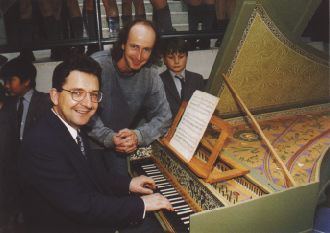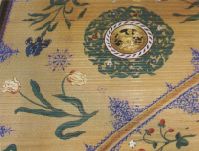Press GalleryCopyright © 2002 CBH & individual authors & photographers |
As soon as I saw a Toyota Tarago drive up to the Music Centre with the number plate HPSCHD, I was intrigued. Yes, this had to be the long-awaited delivery of the School’s first harpsichord, a gift of the Barker College Mothers’ Association from the proceeds of their highly successful Spring Art Show. The van driver was Carey Beebe, who is the principal of Carey Beebe Harpsichords in Sydney and the builder of the instrument. In no time at all the instrument was unloaded into the Atrium, set up, and responding to the gentle caress of Music Director, James Allington. I thought I heard the strains of the Handel’s Harmonious Blacksmith!
Carey Beebe is probably the best known and most travelled Australian harpsichord maker. After a music degree and three performance diplomas he trained in harpsichord construction at the leading American workshop of D. Jacques Way. In 1982 he became the youngest ever international agent for world famous Zuckermann Harpsichords Inc. He has scrutinised instruments in museums and private collections, and maintained or prepared instruments for concerts, broadcasts or recordings on five continents.
The handsome new Barker harpsichord was constructed in 1988 for Richard Gill at the Perth Conservatorium. Carey revised the instrument for Barker, ensuring it will meet all our needs for years to come. It has a full 56-note compass and will, for example, fit all of the works of Bach. It also has an exciting visual impact.
 RON WITHINGTON |
| James Allington and Carey Beebe on the morning of the delivery of the harpsichord. The other head (Adam Ingle) and the forest of legs belong to Mrs Samild’s Year 3 Music Class who were only too eager to gather round for a demonstration. |
In a piano the strings are struck. In a harpsichord the strings are plucked, as in a harp, but with the advantage of a keyboard. Carey explained that as the keyboard dimensions of our instrument are much smaller than those of a piano a new technique must be used, with the fingers curled under the hand, and never reaching between the sharps. The harpsichord keyboard is the reverse of the piano keyboard, with black naturals (African ebony, after the French design) and white sharps (beef-bone slips).
 RON WITHINGTON |
| Detail of Diana Ford’s soundboard design |
The vital spruce soundboard has been decorated in the style of early Ioannes Ruckers by former Barker parent, Diana Ford, who is the mother of John (1988), and James (1990) and sister of Tim Gee (1964). Diana has used representations of the flowers such as lilies, anemones and tulips, mixing her colours from pigment powders with gum arabic to achieve authentic shades. Particularly striking are the cobalt blue filigreed borders, drawn freehand with calligraphic accuracy. Di says that all of her work is water soluble and not varnished. “In fact,” she asserts, “it is designed to look best under a layer of dust.” The overall effect is as individual as handwriting, but she says that her finished designs are actually signed with a tiny ladybird – which she challenges the students to find!
The lid decoration, of historic-style block printed papers often used by the Ruckers family, complements quite beautifully both the soundboard design and the subdued green of the case exterior. As a musical instrument the Carey Beebe creation is quite breathtaking: as a furnishing in the Music Centre atrium space (when the summer suns are well and truly over) it will surely look quite superb.
James Allington says that the harpsichord may be played by all School musicians who are learning piano as a diversion from their regular presentation pieces. It will also be available to “Baroque” students, so that they can hear what their pieces sounded like on the instrument which was available when they were composed.
One hopes that Jim can also arrange a concert item or two in the very near future. We have at least one established harpsichord concert player within the Barker family, Brett Leighton (1973) who is lecturer in harpsichord and organ at Linz and Vienna, has given concerts in USA, Europe, Mexico and Japan and regularly travels back home to Australia. The piece I would request? Why, nothing less than the grandeur of Bach’s Prelude and Fugue in E Flat Minor– my 1970s, thirty-three-and-a-third black vinyl version by Robert Veyron-Lacroix, having become hopelessly scratched, and anyway when I tried to play it the other day, my turntable had lost its rubber band!
Article and photographs by Ron Withington
The Barker the quarterly journal of Barker College, Hornsby (Sydney),
January 1999
| Site overview | |
| Harpsichords Australia Home Page |